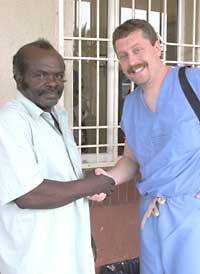Ecuadorian mission work more contagious than it is dangerous
Despite its rough reputation, San Lorenzo clinic offers doctors good working conditions, rewarding results and beautiful views, making it worthy of multiple visits.

Ophthalmic missions are a dangerous proposition. I have told this to a few colleagues and to some of our ophthalmic techs, and several have assumed that I am talking about the involved travel, risky food, endemic diseases or risk of terrorism. Actually, from the many of us who are regularly involved in helping in various places around the world, we know that none of the above is the rationale for the opening statement. To illustrate, let me share a story from a recent trip to Ecuador with Vision Outreach International.
 John A. Hovanesian |
San Lorenzo is a small seaport town known for being a relatively rough and dangerous place. While there, we heard the story of the bar owner who killed a man for misbehaving in his bar and left him sitting there stiff until the next morning. George Washington (Jorge), our experienced Ecuadorian ophthalmic technician, told us of how his wife was murdered in front of family members.
Our group was there on the request of a local missionary general surgeon who had taken over a small clinic and operating room, which had been used for years as an ophthalmic center for the treatment of river blindness. The experienced eye workers were still there, but they no longer enjoyed the visits of any ophthalmic surgeons.
Working conditions
To our amazement, when we arrived we found a clean, air-conditioned operating room with a Zeiss operating microscope in excellent condition. There were unused ophthalmic instruments and sutures sitting on the shelves and even a few old IOLs. We unpacked our gear and set up our usual two beds in one operating room, to be ready for the week’s surgeries.
The week started out as expected with the seemingly endless line of needy patients the first day, which quickly filled out the week’s surgical schedule. Although I had been on many trips as a child with my father, a physician, and a few as a medical student, it was my first trip as an ophthalmic surgeon, despite being in practice for more than 10 years.
Vision Outreach’s protocol that an experienced small-incision cataract surgeon (Dr. David Brown) teach a phaco surgeon (me) the tricks of the trade in a hands-on mini skills transfer course were about to be tested again.
Day 1 went amazingly smooth, and by day 2, both surgeons were starting to pick up speed and momentum. The 4 days of operating flew by, and the exciting postop mornings were highlights as we removed patches and watched many big smiles develop. One particular man was glad to have his photo with me as we shook hands. For whatever reason, he was the only patient of the whole bunch that was photographed with his surgeon. I remembered his face and gentle spirit as I reflected on the photo weeks later.
Bringing it home
|
Image: Pletcher S |
Safely home, 2 months later, I received a newsletter from the missionary general surgeon at the San Lorenzo clinic where we had been. With surprise, I read with interest as the picture on the front happened to be that of the same quiet man whom I had captured in my photo; this time he was standing next to a smiling Jorge. Previously unknown to me, the story reported that Eugenio was one-eyed and had a mature cataract in his only seeing eye. Because of his sight, he had been forced to stop working, depriving him of his livelihood and any income. Because of the dire circumstances, he had looked for a way to kill himself.
Fortunately, a friend had heard about the eye team in San Lorenzo and brought Eugenio to the clinic and paid the $80 for the surgery. The excited patient, now seeing, was thrilled, and Jorge had grabbed the general surgeon to relay the happy story and show off the excited postop patient now 6 weeks out. Eugenio related to them how his life had completely changed, and he now could walk home unassisted to his previous home village and livelihood.
If you are wondering about the dangerous part of our mission, pay attention, for this is where it comes into play. Not long ago, an e-mail came in from our missionary general surgeon friend in Ecuador. She requested another visit from a Vision Outreach team to the clinic. This time she had more patients lined up and a family of three young kids and their mother, all with bilateral cataracts.
Exactly 1.5 years later, after our first visit, a Vision Outreach team returned to help, fulfilling her request. The lead surgeon this time was none other than me (a somewhat experienced small-incision cataract surgeon), ready and eager to teach the phaco surgeon recruited to go with the team, Dr. Ran Ben-Cnaan, of Tel Aviv, who had volunteered to go with us for his first trip. The team had a wonderful trip, operating on many needy patients, being entertained in one patient’s home and climbing some tall mountains in beautiful Ecuador.
So why are missions so dangerous? It’s that they are dangerously contagious, sometimes just after a single time. Just ask Dr. Ben-Cnaan, the latest convert. He can tell you.
For more information:
- Stan Pletcher, MD, can be reached at Great Lakes Eye Care, 2848 Niles Road, St. Joseph, MI 49085-3352; 269-428-3300; e-mail: spletcher@gmail.net. He is the founder of www.missioneyes.net, a Web site that recruits surgeons for ophthalmic missions.
- Visit Vision Outreach International online at www.visionoutreach.org.

